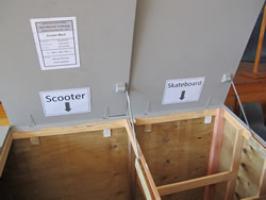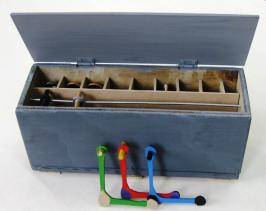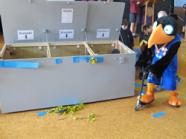Scooter and skateboard rack
Year 8 students from Kowhai Intermediate in central Auckland identified an authentic and local need for the storage of scooters and skateboards in their school. Their challenge was to design and develop a scooter and skateboard rack for all students at their school.
Beginnings
The project started when the school took part in the Transpower Neighbourhood Engineer Awards. Student Kieran McLean was the leader of a group of students who, with the help of Engineer Bella Franks, researched different ways that the school could be improved.
After conducting interviews with staff in the school, the students identified several ongoing relating to storage. The team looked into each and decided that finding a solution for storing the student’s scooters took priority because this affected the largest number of students and staff.
“When the students dropped their scooters and skateboards off in the reception area, the receptionists had to move them all to the storage room, then open the storage room to let the kids take their things at the end of the day,” teacher Sam Ibrahim explained. “This was a really long procedure that had to be done every morning and afternoon.”
The scooters also created a mess in the reception area and took up too much space in the confined space of the storage room.
Planning

Inside the scooter and skateboard rack.
To show the legitimacy of the project, as well as to give valuable information about the specifications that a storage solution would need, the students carried out a survey over a week to find out the number of students using scooters each day.
The students then surveyed the school grounds to find the best spot for a potential scooter rack, taking into account environmental factors such as safety, security, and convenience. This also helped to determine the dimensions of the rack and whether it would have to be weather-proofed for outdoor use. After speaking to the principal and the reception staff, a spot was chosen next to an existing bicycle rack at the front of the school grounds.
Modelling
Next, the students measured some standard scooters to get the range of dimensions required for a storage solution. The students began sketching their then running them past the team until a joint decision could be made on which design to develop further. They consulted with Bella to get her feedback – which helped to finalise the size and shape of their design. Bella also gave the students valuable advice on what materials or coatings would be best for protecting the scooter rack from sun and rain.
When the final drawings were complete, team leader Kieran was assigned the task of creating a 3-D functional of the design in MDF. The students decided this was the best way to showcase their design to their stakeholders.

The students transferred each part of the design drawings to wood, measuring carefully to maintain the right scale. Using MDF, the functional was then constructed using a scroll-saw, PVA glue, and nails. The students also created wooden, scale scooters that could slot into the rack clearly demonstrating its size and function.
Outcome
Approval was given from the Kowhai Intermediate Board of Trustees to fund the production of the scooter rack – based on the evidence presented through the students’ project.
Teacher Sam Ibrahim began constructing a prototype of the scooter rack using the design given to him by the students as a guide. He modified the design to accommodate skateboards. The students helped him with the construction and painting, and a prototype of the rack was completed.
An opening ceremony for the scooter rack was held. The ceremony was attended by Auckland Transport mascot Maxx the Pūkeko – as an acknowledgment of the school’s commitment to reducing traffic congestion through encouraging the use of alternative modes of transport.
This solution has solved a major congestion and organisational , and encouraged the use of scooters and skateboards.
Teacher comment
I have really enjoyed working with Kieran, his friends, and the engineer on this project. The students learned a lot from this unique experience, including how to:
- conduct interviews
- have discussions with teachers and students about problems and solutions
- develop solutions to problems.
Kieran has learnt to design and sketch using a T-square, set square, and tracing paper and has gained an understanding of the importance of using materials like cardboard to create functional to test design ideas.

